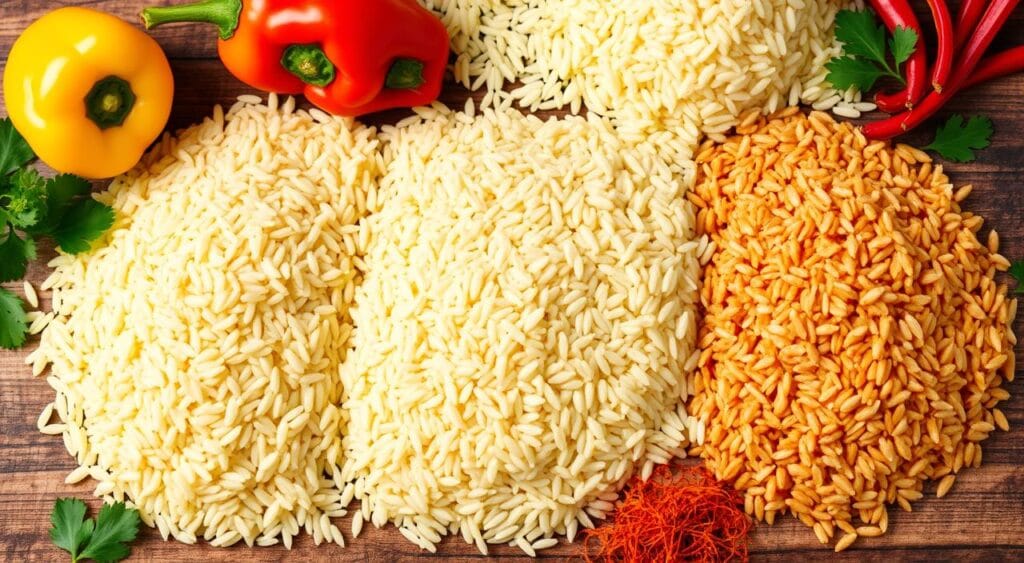Jump to:
Estimated reading time: 9 minutes
Table of contents
Arroz con Pollo is a favorite dish in Latin America. It mixes seasoned rice with tender chicken. But, getting the right texture can be tricky. Many people struggle with their arroz con pollo turning mushy.
It’s important to know why this happens and how to fix it. This way, you can make a dish that tastes great and looks good too.
Key Takeaways
- Arroz con Pollo is a popular Latin American dish known for its rich flavors and comforting qualities
- Mushy texture in arroz con pollo can be caused by using the wrong type of rice, adding too much liquid, or overcooking the dish
- Effective troubleshooting techniques include draining excess liquid, sautéing the dish to evaporate moisture, and adding more dry ingredients to absorb liquid
- Preventing mushy arroz con pollo in the future involves choosing the right rice, measuring liquids accurately, and cooking at the proper temperature and time
- Tips for achieving the perfect texture include toasting the rice, letting the dish rest before serving, and using a lid to control moisture levels
Introduction
Arroz con pollo is a favorite in Latin American cuisine. It’s a chicken and rice dish known for its rich flavors and comfort. But, many wonder, “Why is my arroz con pollo mushy?” This article will look into why it happens and give tips to fix it.
Getting the right texture is key to a great arroz con pollo. It should have tender rice and juicy chicken. Whether you’re experienced or new to cooking, knowing what makes it mushy is crucial.
“Arroz con pollo is a staple in many Latin American households, celebrated for its rich flavors and comforting qualities.”
Many things can affect the texture of your arroz con pollo. We’ll explore these factors in the next sections. You’ll learn how to avoid mushiness and cook it perfectly every time.

If you love Latin American cuisine or want to try cooking this dish, this guide is for you. It will help you improve your arroz con pollo and make it even better.
Common Causes of Mushy Arroz con Pollo
One of the main reasons arroz con pollo turns mushy is overcooking. When rice cooks too long, it soaks up too much liquid. This makes it soft and sticky. The liquid-to-rice ratio is also key, as too much liquid makes the rice absorb more than it should, leading to mushiness. Also, the type of rice used greatly affects the texture. Long-grain rice is best for a fluffy, distinct texture.
Using the Wrong Type of Rice
Choosing the right rice varieties for arroz con pollo is crucial. Long-grain rice, like parboiled or basmati, is the top choice. These types of rice are firmer and drier, which helps them stay fluffy during cooking. Short-grain or sticky rice, on the other hand, absorbs too much moisture, making it soft and clumpy.
Adding Too Much Liquid to the Pot
The liquid-to-rice ratio is a delicate balance. Too much broth, water, or other liquids can make the rice mushy. It’s important to follow the recipe’s liquid-to-rice ratio and adjust as needed during cooking.
Overcooking the Dish or Not Timing It Properly
It’s vital to watch the cooking time and temperature to avoid mushy arroz con pollo. Cooking it too long or at too high a temperature can make the rice absorb too much liquid. On the other hand, not cooking it enough can leave the rice crunchy. Monitoring the cooking time and temperature carefully is key to getting the right texture.

“Achieving the perfect texture for arroz con pollo requires a delicate balance of the right rice variety, proper liquid-to-rice ratio, and precise cooking time and temperature.”
How to Fix Mushy Arroz con Pollo
If your arroz con pollo turned out mushy, don’t worry. There are ways to fix it. Try spreading the rice on a baking sheet to cool. This helps evaporate some of the excess moisture.
Sautéing the rice in a pan with oil can also crisp it up. You can add more dry ingredients like additional rice or toasted nuts to soak up the liquid.
Draining Excess Liquid Without Losing Flavor
Draining excess liquid is key to fixing mushy arroz con pollo. Scoop out the rice, letting the liquid drain. Keep the flavorful cooking juices and mix them back in when sautéing.
Sautéing the Dish to Evaporate Moisture
After draining, sauté the rice in a hot skillet or pan. Stir constantly over medium-high heat. This method evaporates the remaining moisture, making the rice drier and fluffier. Watch the rice closely to avoid drying or burning it.
Adding More Dry Ingredients to Absorb Liquid
If the rice is still too moist, add dry ingredients to absorb the excess liquid. Try toasted nuts, breadcrumbs, or more uncooked rice. Mix these gently into the dish to balance the moisture and texture.
“The key to a perfect arroz con pollo is striking the right balance between moisture and texture. With a little trial and error, you can easily transform a mushy dish into a delightful, flavorful one.”
Preventing Mushy Arroz con Pollo in the Future
To make sure your arroz con pollo is perfect, focus on a few key things. These include the type of rice, the liquid-to-rice ratio, and the cooking temperature and time. By getting these right, you can avoid the mushy texture and enjoy a fluffy, flavorful dish.
Choosing the Right Rice: Long-Grain vs. Short-Grain
The type of rice you choose is very important for the texture of your arroz con pollo. Long-grain rice, like basmati or jasmine, makes the dish lighter and fluffier. Short-grain rice, however, can make it sticky and mushy.
Measuring the Liquid and Rice Ratio Correctly
It’s crucial to balance the liquid and rice correctly to avoid mushiness. A good rule of thumb is to use a 1:1 ratio of liquid to rice. So, if you use 3 cups of rice, add 3 cups of broth or water. Even a small change in this ratio can affect the texture.
Cooking at the Proper Temperature and Time
It’s important to cook at the right temperature and for the right amount of time. Cook the dish at a gentle simmer, not a rapid boil. This helps prevent it from drying out. Also, watch the cooking time closely to avoid overcooking, which can make the rice mushy.
By choosing the right rice, measuring the liquid and rice ratio accurately, and cooking at the proper temperature and time, you can make a delicious arroz con pollo. This dish will be fluffy and flavorful, without the mushy texture.
Tips for Achieving the Perfect Arroz con Pollo Texture
Making the perfect Arroz con Pollo is an art. The key is mastering the texture. Techniques like toasting rice and letting the dish rest are crucial.
Toasting the Rice Before Adding Liquid
Toasting the rice before adding liquid prevents mushiness. It creates a barrier that keeps the rice fluffy. Toasting the rice in oil or butter for a few minutes makes a big difference.
Letting the Dish Rest Before Serving
Letting the dish rest is another key technique. After cooking, cover it and let it sit for 10-15 minutes. This resting period makes the rice fluffier and more cohesive.
Using a Lid to Control Moisture Levels
Keeping a tight-fitting lid during cooking is essential. It traps steam, ensuring the rice cooks perfectly. This helps maintain the fluffy and separate grain texture.
“Mastering the techniques for the perfect Arroz con Pollo texture is the key to creating a truly authentic and delicious dish.”
FAQ: Why Is My Arroz con Pollo Mushy?
Why does Arroz con Pollo turn out mushy?
Arroz con Pollo can become mushy if there’s too much liquid or if the rice is overcooked. Rice absorbs liquid quickly, and extra moisture can lead to a soggy texture. Cooking with the correct amount of broth and keeping a close eye on cooking time helps prevent this.
How much liquid should I use in Arroz con Pollo?
For Arroz con Pollo, use a rice-to-liquid ratio close to 1:1.5, though it can vary based on rice type. Start with less liquid, then add more if needed, as rice can quickly absorb too much, making it mushy.
Should I use high or low heat when cooking Arroz con Pollo?
Start with medium-high heat to cook the chicken and vegetables, then lower the heat to a gentle simmer when adding the rice and broth. This slow cooking helps the rice absorb flavors without becoming overly soft.
Can I fix mushy Arroz con Pollo?
If your Arroz con Pollo turns out mushy, spread it on a baking sheet and bake at a low temperature to remove some moisture. Alternatively, next time, try reducing the liquid or cooking the rice for a shorter time.
What type of rice is best to avoid mushiness?
Long-grain rice or parboiled rice can help reduce the chance of mushiness, as these types stay firmer and absorb less liquid than short or medium grains, commonly used in traditional recipes.
Conclusion: Mastering the Perfect Arroz con Pollo Texture
To get the perfect texture for your arroz con pollo, you need the right ingredients and cooking skills. This article gives you tips and ways to fix common texture problems. With these, you can make your arroz con pollo look great and taste amazing.
Choosing the right rice and the right amount of liquid is key. Also, toasting the rice and controlling the cooking time and temperature are important. Letting the dish rest before serving helps too.
With practice and focus, you’ll get better at making arroz con pollo. The tips in this article will help you make a dish that everyone will love. Enjoy making this classic dish and enjoy the delicious results of your hard work.






